

| The Centipedes and Millipedes of Nottinghamshire | ||
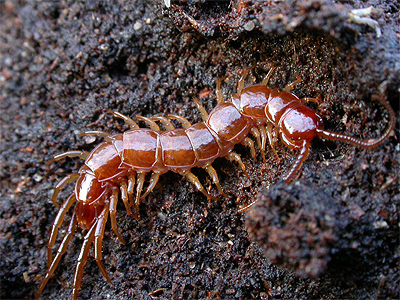 |
Centipedes and Millipedes
are probably as well known and instantly recognisable to
those with little or no interest in Natural History, as
Butterflies and Moths. Despite their abundance, Centipedes and Millipedes (Myriapods) remain another neglected group in terms of study and identification. Even the Victorian naturalists showed next to no interest in them and so we still know virtually nothing about the range of the species occurring in Nottinghamshire, or even about what species actually occur. Centipedes and Millipedes are difficult to identify, rarely being possible to identify them from photographs taken in the field, so taking a specimen is often neccessary. |
|
| ..... | ||
| Centipede
and Millipede life history Difficulties in identification, may have been one of the key factors in these invertebrates being severely neglected by naturalists. We have only very recently taken an interest in them ourselves, but they are fascinating invertebrates with interesting life histories. Male Centipedes spin a small web of silk onto which they deposit sperm. The sperm is then picked up by the female, using her modified front legs and can be stored by the female for many months. |
||
| ..... | ||
| In early 2013, we found
and photographed this act ourselves, when two Lithobius
forficatus were discovered on the underside of a
log. The male had just deposited the sperm onto the web,
which the female collected before making her escape. The
photograph on the right is probably quite unique, as we
have yet to trace another showing this procedure on the
internet. Lithobius Centipedes lay their eggs singly and exhibit no brood care, but the females of some species (Geophilids especially) excavate special brood chambers in the soil and remain with the young until they are large or old enough to fend for themselves. The brooding Geophilid easoni female on the lower right, was found under a rotting tree stump in 2012. The chamber was located deep in the soil. Young Geophilid Centipedes differ from Lithobius Centipedes by having the full compliment of legs from birth, but young Lithobius Centipedes have to pass through several stages before gaining fifteen pairs of legs. |
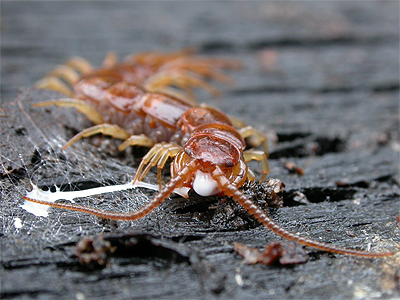 |
|
| ..... | ||
| The young of all
Centipedes are at risk from a range of predators, but as
they reach maturity, are more than capable of looking
after themselves. Once mature, Centipedes are higher up
the food chain and will take many invertebrate prey
types. Springtails, Earthworms and Spiders are among the range of invertebrates predated and although Centipedes will travel in search of food, in many instances, food may well find them as they lie in wait. Millipedes reproduce differently to Centipedes. The transfer of sperm from the male to the female is by modified limbs called Gonopods. On many male Millipede species, these are located on the underside of the seventh body segment. Eggs laid by the female, hatch into almost formless grubs which are known as Pupoids. When the Pupoid moults, the first legs are produced and with subsequent moults, the number of legs increases until the full compliment is reached on maturity. |
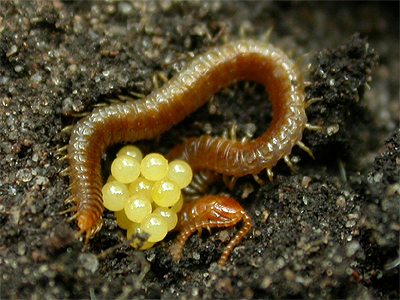 |
|
| ..... | ||
| Basic
structural differences between Centipedes and Millipedes Without going into too much detail into the differences between Centipedes (Class Chilopoda) and Millipedes (Class Diplopoda) it is possible to give a brief summary. Centipedes are carnivorous, with the front legs modified into poison claws. Adult Lithobidae have 15 pairs of legs, whereas the Geophilidae have more than 35 pairs. The number of antennal segments varies with age, as new segements are gained during a succession of moults. Millipedes generally two pairs of legs per body segment, compared to just the one in Centipedes. They have robust mandibles for chewing a diet of vegetable matter. There are six general forms of Millipede, each form showing a wide range of shape which are distinctive once learnt. We have included several examples in this selection of photographs. A Geophilid Centipede is shown top left, with a typical Lithobius Centipede below and Haplophilus subterraneus, a species well known to gardeners. The three photographs on the right show one of the Snake Millipedes (top), with an example of a Flat-backed Millipede and then a Pill Millipede below. At first glance, the Pill Millipede may easily be mistaken for a Woodlouse, but there are clear differences in the antennal structure of Centipedes, Millipedes and Woodlice. |
||
| ..... | ||
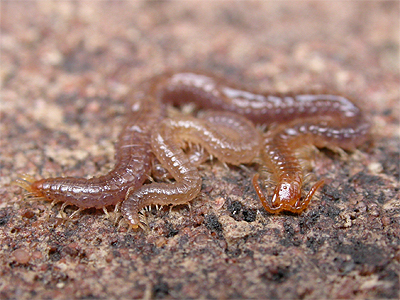 |
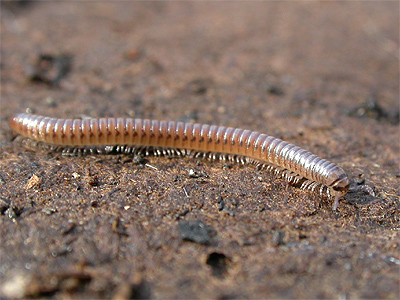 |
|
| ..... | ||
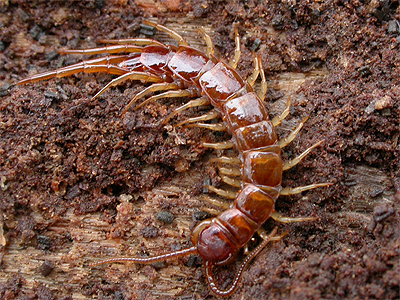 |
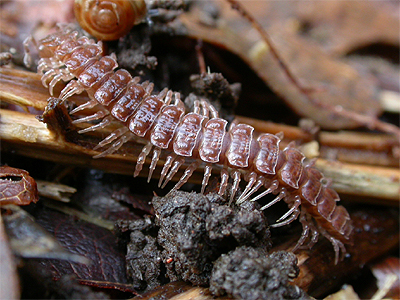 |
|
| ..... | ||
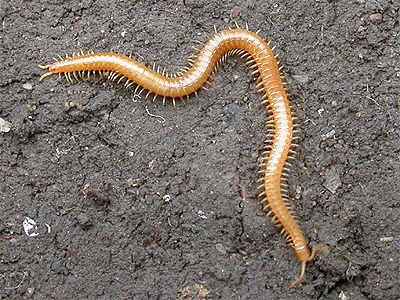 |
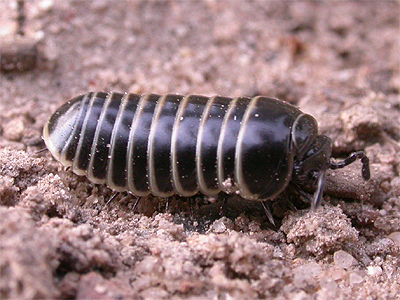 |
|
| ..... | ||
| Nottinghamshire
species As is usual, the amount of data and information regarding the status of many invertebrate groups in Nottinghamshire, has been rather difficult to trace. The following species have been recorded in Nottinghamshire. Once again we have relied heavily on records produced by J.W. Carr in his book "The Invertebrate Fauna of Nottinghamshire". In October 2014, Tony Barber very kindly sent us all Nottinghamshire records held by the British Myriapod and Isopod Group, which have given us a more accurate picture of species' distribution in the county. |
||
| ..... | ||
| Centipedes | ||
| Haplophilus subterraneus, Schendyla nemorensis, Strigamia acuminata, Geophilus carpophagus, Geophilus easoni, Geophilus electricus, Geophilus flavus, Geophilus insculptus, Geophilus truncorum, Cryptops anomalans, Cryptops hortensis, Lithobius calcaratus, Lithobius crassipes, Lithobius curtipes, Lithobius forficatus, Lithobius melanops, Lithobius microps, Lithobius muticus, Lithobius variegatus, Lamyctes emarginatus and Scutigera coleoptrata. | ||
| ..... | ||
| Millipedes | ||
| Polyxenus lagurus, Glomeris marginata, Brachychaeteuma bagnalli, Nanogona polydesmoides, Chordeuma proximum, Melogona scutellaris, Oxidus gracilis, Brachydesmus superus, Polydesmus angustus, Polydesmus coriaceus, Polydesmus inconstans, Ophiodesmus albonanus, Macrosternodesmus palicola, Choneiulus palmatus, Proteroiulus fuscus, Blaniulus guttulatus, Archiboreoiulus pallidus, Boreoiulus tenuis, Nemasoma varicorne, Julus scandinavius, Ophyiulus pilosus, Leptoiulus belgicus, Cylindroiulus britannicus, Cylindriolus caeruleocinctus, Cylindroiulus punctatus, Brachyiulus pusillus, Ommatoiulus sabulosus and Tachypodoiulus niger. | ||
| ..... | ||
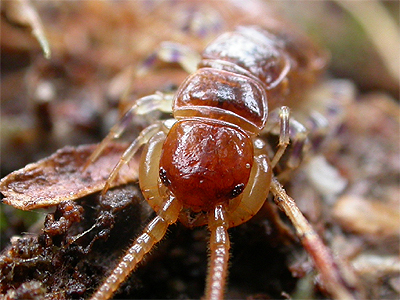 |
It is likely that most
species listed as occurring in Nottinghamshire are still
present and fairly widespread. Its just that no one is
looking for them. On a cold, wet day in early March 2013,
we brought home a carrier bag of leaf litter and moss
collected at Sherwood Forest CP and promptly found
Nottinghamshire's first record of Lithobius muticus.
There is no doubt that more new species for the county are still waiting to be found and certainly for many Centipedes and Millipedes, they have not been recorded, or records submitted in over a century. Centipede bioluminescence Like many invertebrates, its not until you look more closely at them, that you realise what amazing things they are. They are superbly adapted for their ground or subterranean existence, with the ability to suddenly disappear down the smallest crack in the soil. Some species, or possibly just one (no one really knows exactly how many) have the ability to produce their bioluminescence through internal chemical reaction. |
|
| ..... | ||
| With our
strong interest in Glow Worms, it may be that
bioluminescence was the key factor in us taking a greater
interest in Centipedes and Millipedes. Accounts of glowing Centipedes are very few and are usually from members of the public out walking late at night. Most accounts of such instances have come during the Autumn months and are always chance encounters. There were very few useful reports on the internet, but there was one on the UK Glow Worm Survey website. But it seems that the few reports there are, all came from members of the public, who's reported sightings often tend to be extremely vague and usually of little accuracy. Myriapod bioluminescence has been recorded by very few naturalists, so we were incredibly fortunate to have our own such encounter in Spring 2012. It came on May 29th 2012, during what was yet another blank night for Glow Worms at Clipstone Old Quarter. But on the top path of our survey route (which is the darkest section on site) we spotted a bright glow ahead of us and immediately thought the first Glow Worm had appeared and that it had somehow been missed on the first walk a few minutes previous. Then we thought it must be a glowing larva located under a few leaves on the edge of the path. We were stunned when after kneeling down for an investigative look, suddenly saw a Geophilid Centipede glowing totally from end to end as it moved about on the path surface. Even more interesting was the strong trail of glowing droplets of liquid left in its path. The Centipede glowed for at least 15 seconds and it may have only stopped glowing after an unsuccessful attempt to pot it, but the droplets forming the trail continued to glow for longer. Confirmation of bioluminescence produced by Geophilus easoni We recently recorded a further example of bioluminescence produced by a Centipede on April 13th 2013. The Centipede was collected and following examination turned out to be Geophilus easoni, a heathland species which we regularly find around the Sherwood Forest area. The identification was also confirmed initially by Keith Lugg via Facebook and then by Tony Barber (the UK Centipede recording scheme organiser) from two specimens which we later posted to him. The specimen was found after dark at Clipstone Old Quarter, but was only discovered when it produced a trail of bioluminescent fluid, after almost being trampled on. It did not glow bodily and is not thought to be the same species we recorded at the end of May 2012, but the bioluminescent fluid was easily visible from at least two metres away. The bioluminescence lasted between two and three minutes and when caught, pressing down on the Centipede would produce the same reaction. |
||
| ..... | ||
| Following on from this
record, we began to undertake field work to try and gain
additional evidence and observational notes. We also wanted complete confirmation to our initial identification of G. easoni, ending the still scientifically unknown answer to the question, as to precisely which Centipede (or possibly Centipedes) has the ability to create its own bioluminescence. So two specimens were sent to Tony Barber of the British Myriapod and Isopod Study Group, who quickly confirmed that both were indeed Geophilus easoni. It seems strange that no one had determined bioluminescence in Centipedes before, although G. easoni had been quoted as being bioluminescent by at least one earlier author. The rarity of such reports may have been why no one has spent any time researching the subject. |
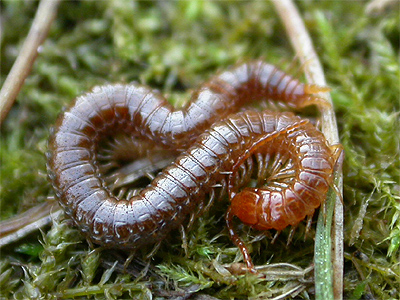 |
|
| ..... | ||
| Three
nocturnal path walks in April and May 2013, yielded a
total of 20 G. easoni (identification later
confirmed before release). Out of the total, 16 produced
varying degrees of bioluminescence. Variability was
recorded in the length of time bioluminescence lasted,
exactly where bioluminescence was emitted from over the
length of the Centipede and the release or non-release of
bioluminescent fluid which was found to have a distinct
odour akin to a sweet urine smell. Specimens in the
larger size range (probably all mature females) seemed to
react better than smaller specimens. Having such a thin-bodied subject and being in total darkness, did cause us problems in determining exactly where bioluminescence was emitted from. We did not record any specimen becoming completely bioluminescent, but some abdominal sections (tergites) were seen to light up, then fade out, then occasionally lighting up again. Bioluminescent fluid is almost certainly emitted from the underside and possibly from the rear end or the last few tergites. Fluid remains in a state of bioluminescence for around 10-20 seconds, but the odour lasts at least several hours. In another experiment, we tested three specimens of Stigmatogaster subterranea caught earlier in the day. No bioluminscence was recorded and work is continuing. |
||